COMMENT OF THE DAY: THE WATER WILL ALWAYS COME AND MOVE STUFF AROUND  “I hope these detention pools make a difference but I doubt they will: Less likely since the rooted greenery is being removed. Flood events will always tear up a riverbed and its plants. The best thing to do is to let the vegetation grow up until the next flood event — that’s the cheapest most efficient tactic. If a future flood event takes people’s back yards away then that’s just tough for those homeowners. In spots, Buffalo Bayou is a lovely, primeval place to take a canoe trip. In spots it’s a trash heap. It’s always interesting though!” [movocelot, commenting on New Overflow Pools Coming To Clear Out Trees, Anthills from the South Side of Buffalo Bayou] Illustration: Lulu
“I hope these detention pools make a difference but I doubt they will: Less likely since the rooted greenery is being removed. Flood events will always tear up a riverbed and its plants. The best thing to do is to let the vegetation grow up until the next flood event — that’s the cheapest most efficient tactic. If a future flood event takes people’s back yards away then that’s just tough for those homeowners. In spots, Buffalo Bayou is a lovely, primeval place to take a canoe trip. In spots it’s a trash heap. It’s always interesting though!” [movocelot, commenting on New Overflow Pools Coming To Clear Out Trees, Anthills from the South Side of Buffalo Bayou] Illustration: Lulu
Flooding

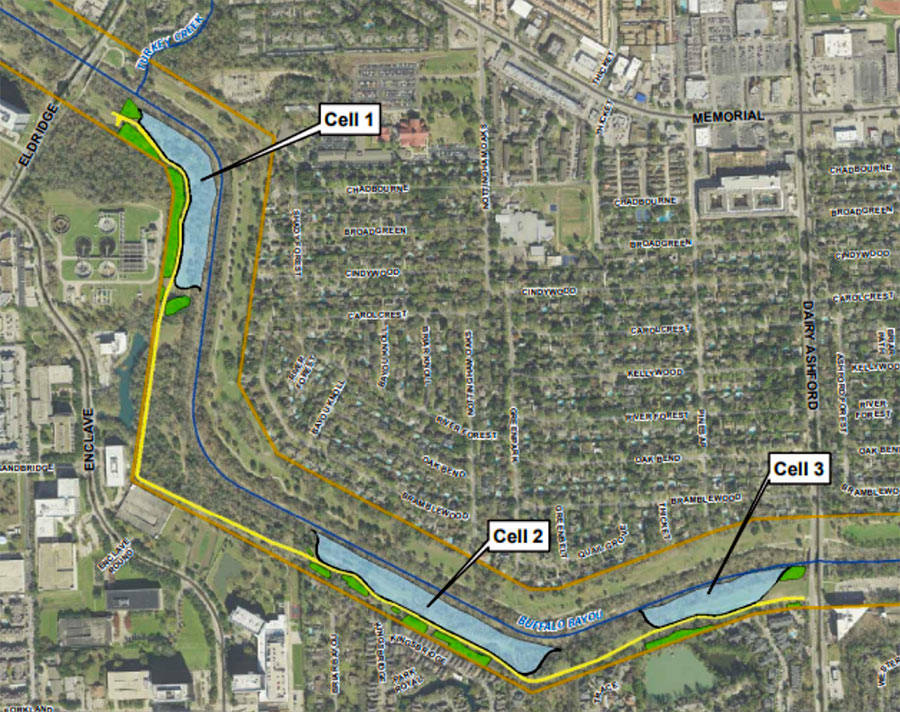
Time’s almost up for a whole mess of trees lining the south side of Buffalo Bayou between Eldridge Pkwy. and Dairy Ashford (pictured at top), where the Harris County Flood Control District plans to construct the first 3 of a series of overflow basins. Removal of vegetation across the bayou from Nottingham Forest’s southern border is scheduled to begin within a few weeks; construction company Lecon has the $1.8 million contract to build the “linear stormwater detention compartments,” which are meant to accommodate a temporary visit of up to 90 acre-ft. of bayou water during a flood.
The trees and basins will be carved out of Terry Hershey Park. The district notes that some trees and vegetation may be preserved — forming a buffer “where possible” between the basins and private property to the south. Large sections of the popular Anthills Mountain Bike Trail, which the district notes “were built on publicly-owned land without written permission and without compensation to the public” will be cleared, though a portion that sits between the 2 westernmost basins will remain.
NEWLY-PROPOSED STATEWIDE FLOODING FUND WOULD BE SPRINKLED WITH $1.2B FROM TEXAS’S RAINY DAY RESERVES 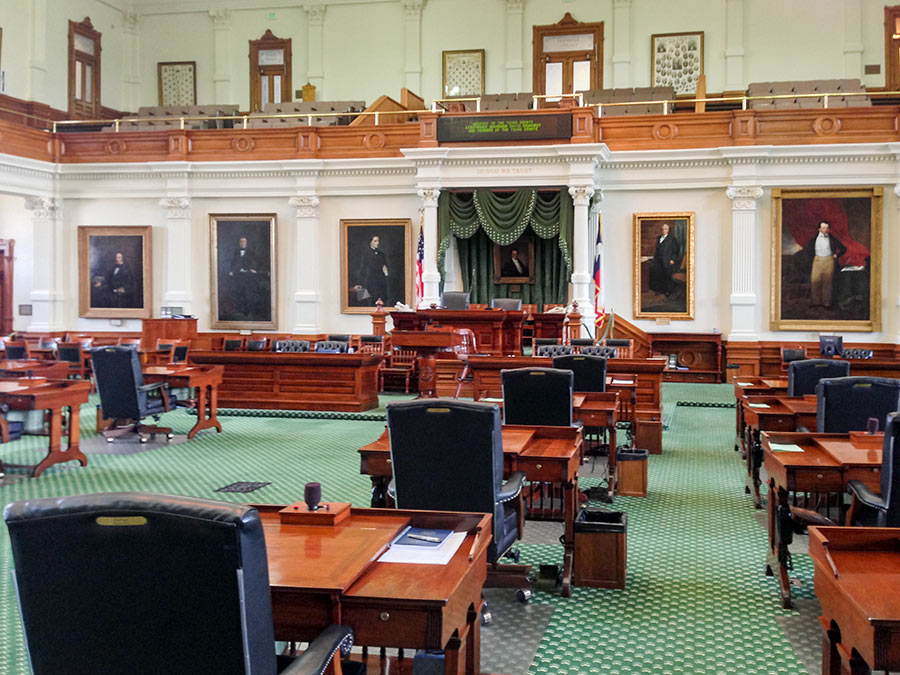 State Senator Charles Perry filed a trio of bills on Tuesday that aim to create a state-level plan for flood mitigation, to be funded by $1.2 billion drawn from Texas’s $11 billion rainy day fund, reports the Texas Tribune’s Carlos Anchondo. If the House and Senate agree to tap the state’s nest egg by a two-thirds vote — a level of consensus that’s proven difficult to reach in the past, notes Anchondo — the legislation would then divide Texas into regional flood planning groups that trace the outlines not of municipalities, but rather of the state’s watersheds in order to “ensure one community’s plans do not inadvertently negatively impact a neighboring community,” says Perry. (The Texas Water Development Board would oversee the mapping and could choose to deviate from watershed boundaries in exceptional cases.) Within every watershed group, a representative from each county would receive a single vote, which they’d use to hash out a regional flood plan including both physical projects (such as reservoir improvements) and strategies (such as strengthening building codes). Taking a look at each region’s plan, the state would then compile a ranked list of flood mitigation approaches across Texas and kick in portions of the $1.2 billion for them accordingly starting sometime in 2024 . . . at the earliest. [Texas Tribune; press release] Photo of the Texas Senate chamber: Arthur LeBon [license]
State Senator Charles Perry filed a trio of bills on Tuesday that aim to create a state-level plan for flood mitigation, to be funded by $1.2 billion drawn from Texas’s $11 billion rainy day fund, reports the Texas Tribune’s Carlos Anchondo. If the House and Senate agree to tap the state’s nest egg by a two-thirds vote — a level of consensus that’s proven difficult to reach in the past, notes Anchondo — the legislation would then divide Texas into regional flood planning groups that trace the outlines not of municipalities, but rather of the state’s watersheds in order to “ensure one community’s plans do not inadvertently negatively impact a neighboring community,” says Perry. (The Texas Water Development Board would oversee the mapping and could choose to deviate from watershed boundaries in exceptional cases.) Within every watershed group, a representative from each county would receive a single vote, which they’d use to hash out a regional flood plan including both physical projects (such as reservoir improvements) and strategies (such as strengthening building codes). Taking a look at each region’s plan, the state would then compile a ranked list of flood mitigation approaches across Texas and kick in portions of the $1.2 billion for them accordingly starting sometime in 2024 . . . at the earliest. [Texas Tribune; press release] Photo of the Texas Senate chamber: Arthur LeBon [license]
NEW TEXAS SENATE BILL: IF HOME LIES IN ANY FLOOD ZONE, SELLER MUST SAY SO 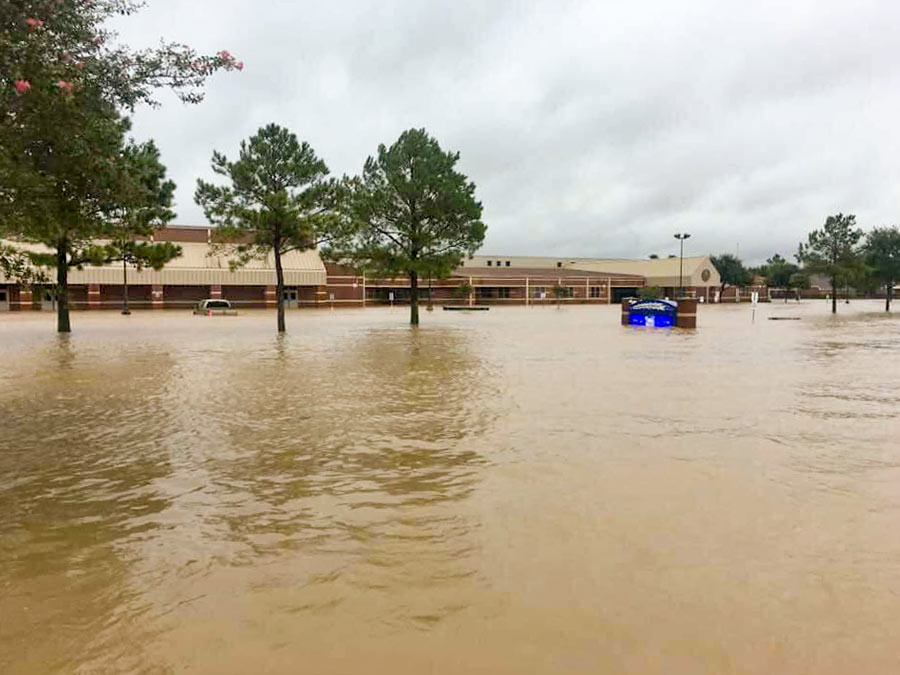 State Senator Joan Huffman filed a bill last Friday that, if passed, would require sellers to tell buyers if their homes are located in a 100- or 500-year floodplain, a reservoir, or a flood pool — the area next to a reservoir that’s expected to fill up with water during major flooding events (but that most were unaware of until reporters blew the lid on their existence in late 2017). The bill, S.B. 339, would also force owners to disclose whether the home they’re listing has flooded before, whether it might flood under “catastrophic circumstances,” and if it’s located less than 5 miles downstream from a reservoir. “If a seller doesn’t disclose the information,” reports the Texas Tribune’s Kiah Collier, “the law would allow buyers to terminate the contract — or sue.” [Texas Tribune] Photo of flooding at Creech Elementary School, Katy, near Barker Reservoir: Breta Gatlin
State Senator Joan Huffman filed a bill last Friday that, if passed, would require sellers to tell buyers if their homes are located in a 100- or 500-year floodplain, a reservoir, or a flood pool — the area next to a reservoir that’s expected to fill up with water during major flooding events (but that most were unaware of until reporters blew the lid on their existence in late 2017). The bill, S.B. 339, would also force owners to disclose whether the home they’re listing has flooded before, whether it might flood under “catastrophic circumstances,” and if it’s located less than 5 miles downstream from a reservoir. “If a seller doesn’t disclose the information,” reports the Texas Tribune’s Kiah Collier, “the law would allow buyers to terminate the contract — or sue.” [Texas Tribune] Photo of flooding at Creech Elementary School, Katy, near Barker Reservoir: Breta Gatlin
COUNTY COMMISSIONERS HOLD OFF ON REPAIRS TO DOWNTOWN’S SOGGY CRIMINAL JUSTICE SKYSCRAPER  The County Commissioners were set to approve repairs to the chronically wet Harris County Criminal Justice Center on Tuesday when District Attorney Kim Ogg — who occupies the building along with her 735 employees — convinced them to tap the brakes, calling it “unseemly . . . that we would be spending $14 million when we still don’t know the cause of the flooding.” Writing in November, the Houston Chronicle‘s Brian Rogers blamed it on: “unprecedented amounts of standing water,” that “seeped into the underground walls” of the building even though its flood gates remained secure. But he noted that some county officials believe there were “multiple sources,” of water and remained unsure about how it all got in. The 18-year-old building at 1201 Franklin St. partly reopened in June. The repairs that the commissioners had planned to authorize this week included fixes to its elevator shafts and parts of floors 2 through 20. (They suffered damage when the electronics in the basement — dampened by floodwaters — malfunctioned, sending gallons of water through the building’s anti-flood pumping system, which ironically, burst pipes and flooded the upper stories.) Following up on Ogg’s remarks, County Engineer John Blount raised the possibility of building a new criminal justice building from scratch. The estimated cost he gave for doing so: $430 million. [Houston Chronicle] Photo: Harris County
The County Commissioners were set to approve repairs to the chronically wet Harris County Criminal Justice Center on Tuesday when District Attorney Kim Ogg — who occupies the building along with her 735 employees — convinced them to tap the brakes, calling it “unseemly . . . that we would be spending $14 million when we still don’t know the cause of the flooding.” Writing in November, the Houston Chronicle‘s Brian Rogers blamed it on: “unprecedented amounts of standing water,” that “seeped into the underground walls” of the building even though its flood gates remained secure. But he noted that some county officials believe there were “multiple sources,” of water and remained unsure about how it all got in. The 18-year-old building at 1201 Franklin St. partly reopened in June. The repairs that the commissioners had planned to authorize this week included fixes to its elevator shafts and parts of floors 2 through 20. (They suffered damage when the electronics in the basement — dampened by floodwaters — malfunctioned, sending gallons of water through the building’s anti-flood pumping system, which ironically, burst pipes and flooded the upper stories.) Following up on Ogg’s remarks, County Engineer John Blount raised the possibility of building a new criminal justice building from scratch. The estimated cost he gave for doing so: $430 million. [Houston Chronicle] Photo: Harris County
COASTAL DEFENSE EXPERTS SAY IKE DIKE WON’T BE ENOUGH WITHOUT A BACKUP WALL 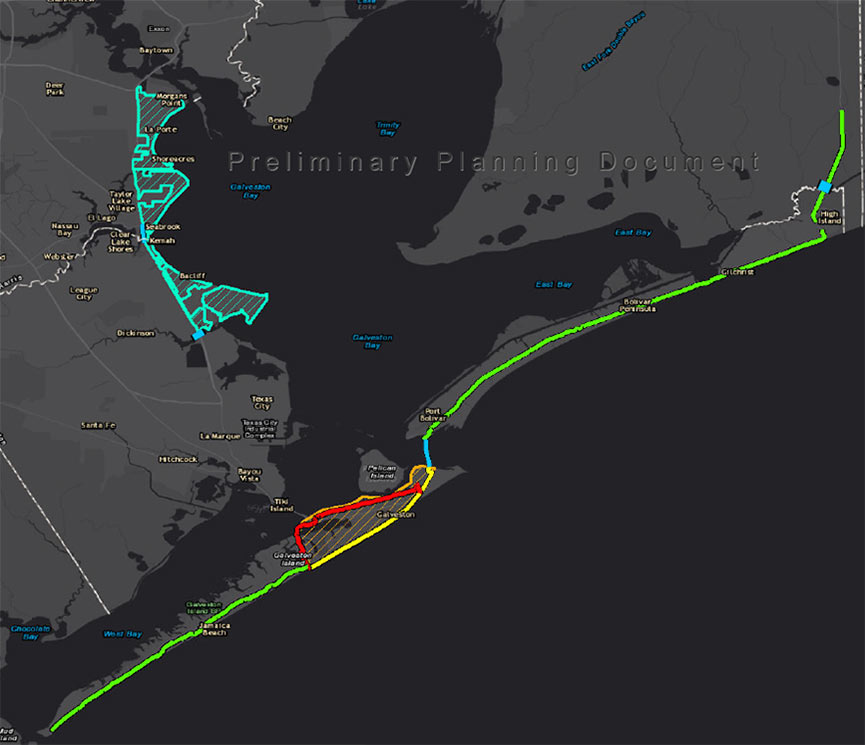 With the public comment period underway on the Ike Dike proposal the Army Corps issued last month, Rice University scientist Jim Blackburn weighs in on the project: “We think that there is too much remaining surge exposure,” he tells the Chronicle‘s Nick Powell on behalf of the research team he heads. Why’s that? “The storms that are being analyzed by the Corps are, in my opinion, too small,†Blackburn says. “They’re just not making landfall at the worst locations, with the type of wind fields and characteristics we’re seeing.” Had the Corps’ methodology accounted for a worst-case storm, says Blackburn, its analysts would’ve seen that the projects they proposed — 70 miles worth of walls and gates between High Island and San Luis Pass — are inadequate without a key addition: an upstream gate that’d run across the middle of Galveston Bay, further shielding the Ship Channel and its adjacencies from floodwaters. “We are going to argue that to any governmental entity that is interested,” says Blackburn, adding, “I think we need options. If all of our eggs are in a $30 billion federal appropriation, that just sounds too risky to me.†One key selling point for the gate: It could be built in about half the time the other proposals would take and at a fraction of their cost, says Blackburn, between $3 billion to $5 billion. [Houston Chronicle ($); previously on Swamplot] Map of Ike Dike proposal: U.S. Army Corps of Engineers
With the public comment period underway on the Ike Dike proposal the Army Corps issued last month, Rice University scientist Jim Blackburn weighs in on the project: “We think that there is too much remaining surge exposure,” he tells the Chronicle‘s Nick Powell on behalf of the research team he heads. Why’s that? “The storms that are being analyzed by the Corps are, in my opinion, too small,†Blackburn says. “They’re just not making landfall at the worst locations, with the type of wind fields and characteristics we’re seeing.” Had the Corps’ methodology accounted for a worst-case storm, says Blackburn, its analysts would’ve seen that the projects they proposed — 70 miles worth of walls and gates between High Island and San Luis Pass — are inadequate without a key addition: an upstream gate that’d run across the middle of Galveston Bay, further shielding the Ship Channel and its adjacencies from floodwaters. “We are going to argue that to any governmental entity that is interested,” says Blackburn, adding, “I think we need options. If all of our eggs are in a $30 billion federal appropriation, that just sounds too risky to me.†One key selling point for the gate: It could be built in about half the time the other proposals would take and at a fraction of their cost, says Blackburn, between $3 billion to $5 billion. [Houston Chronicle ($); previously on Swamplot] Map of Ike Dike proposal: U.S. Army Corps of Engineers
SNEAKING A PEEK AT THE BIG WALLS, BIG GATES ARMY CORPS COULD PROPOSE FOR THE COAST LATER THIS MONTH  On October 26, the agency will single out one of the 4 big proposals it’s been pondering for the Texas coast as the chosen one, reports the Texas Tribune’s Kiah Collier. One of them “calls for the construction of a 17-foot-high levee along the entirety of Galveston Island,” as well as Bolivar Peninsula. Ring any bells? It’s the so-called Ike Dike (also known as the “coastal spine”) that A&M scientists dreamed up about a decade ago in response to the disaster and hypothetically-even-worse disaster that could’ve occurred if Ike had struck 30 miles further west. Another defense against that doomsday scenario that could make it into the proposal: a giant gate structure adapted from Rice’s Jim Blackburn and Philip Bedient’s 2011 idea for a mechanism that’d close before storms to block surge. (They wanted to put it just upstream from the Fred Hartman Bridge; the Corps has number of different spots in mind.) All the plans in the running include a so-called ring levee around Galveston’s bay side to protect it from reverse storm surge, a helping of smaller levees and gates, upgrades to existing flood control structures, and ecosystem restoration projects geared toward creating natural floodwater-fighting barriers. [Texas Tribune; previously on Swamplot] Map indicating proposed Alternative A plan: U.S. Army Corps of Engineers
On October 26, the agency will single out one of the 4 big proposals it’s been pondering for the Texas coast as the chosen one, reports the Texas Tribune’s Kiah Collier. One of them “calls for the construction of a 17-foot-high levee along the entirety of Galveston Island,” as well as Bolivar Peninsula. Ring any bells? It’s the so-called Ike Dike (also known as the “coastal spine”) that A&M scientists dreamed up about a decade ago in response to the disaster and hypothetically-even-worse disaster that could’ve occurred if Ike had struck 30 miles further west. Another defense against that doomsday scenario that could make it into the proposal: a giant gate structure adapted from Rice’s Jim Blackburn and Philip Bedient’s 2011 idea for a mechanism that’d close before storms to block surge. (They wanted to put it just upstream from the Fred Hartman Bridge; the Corps has number of different spots in mind.) All the plans in the running include a so-called ring levee around Galveston’s bay side to protect it from reverse storm surge, a helping of smaller levees and gates, upgrades to existing flood control structures, and ecosystem restoration projects geared toward creating natural floodwater-fighting barriers. [Texas Tribune; previously on Swamplot] Map indicating proposed Alternative A plan: U.S. Army Corps of Engineers
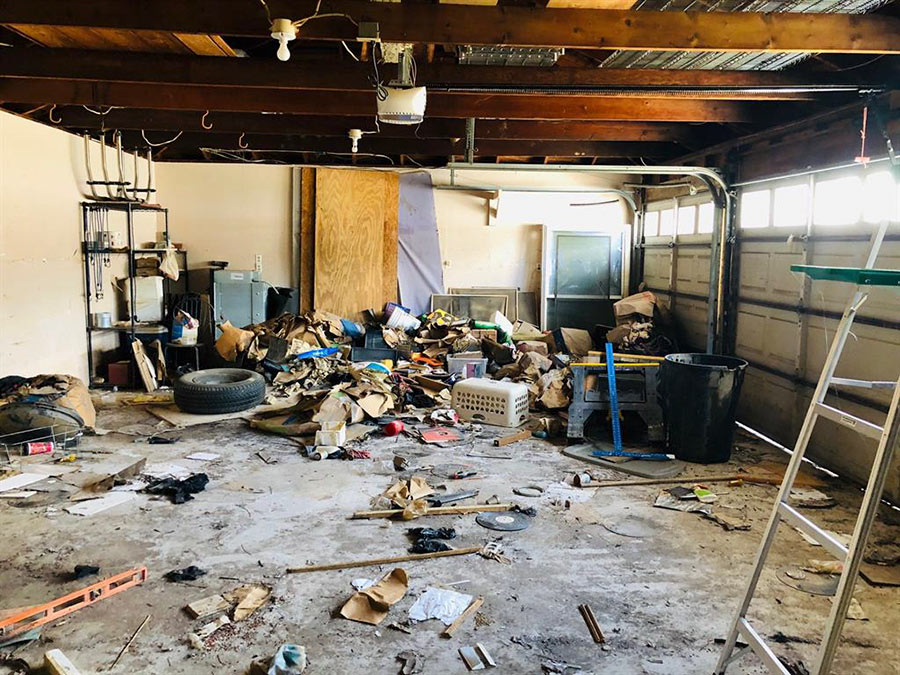
- 4415 Belle Hollow Dr. [HAR]
WHAT’S ON THE TABLE IN HARRIS COUNTY’S FLOOD BOND MEGA VOTE, STARTING TOMORROW  Included in the flood control bond package county residents are about to start voting on: $1.2 billion for channel improvements, $401 million for detention basins, $242 million for floodplain land purchases, $184 million (coupled with $500 million in outside funding) for 3,600 home buyouts, $12.5 million for new floodplain mapping, and $1.25 million for a better flood warning system — according to totals the Chronicle’s Zach Despart summed up from the master list of 237 individual projects. Not included: money for a third reservoir, although $750,000 is on the table to help the Army Corps study the possibility of one. Taken together, the $2.5 billion proposal‘s price tag is more than 20 times the Harris County Flood Control District’s annual budget of $120 million. Voting wraps up on Saturday, August 25, the anniversary of Harvey’s arrival in Houston. [Houston Chronicle ($); full list (PDF); previously on Swamplot] Photo of flooding at Creech Elementary School, 4242 S. Mason Rd., Katy:: Breta Gatlin
Included in the flood control bond package county residents are about to start voting on: $1.2 billion for channel improvements, $401 million for detention basins, $242 million for floodplain land purchases, $184 million (coupled with $500 million in outside funding) for 3,600 home buyouts, $12.5 million for new floodplain mapping, and $1.25 million for a better flood warning system — according to totals the Chronicle’s Zach Despart summed up from the master list of 237 individual projects. Not included: money for a third reservoir, although $750,000 is on the table to help the Army Corps study the possibility of one. Taken together, the $2.5 billion proposal‘s price tag is more than 20 times the Harris County Flood Control District’s annual budget of $120 million. Voting wraps up on Saturday, August 25, the anniversary of Harvey’s arrival in Houston. [Houston Chronicle ($); full list (PDF); previously on Swamplot] Photo of flooding at Creech Elementary School, 4242 S. Mason Rd., Katy:: Breta Gatlin
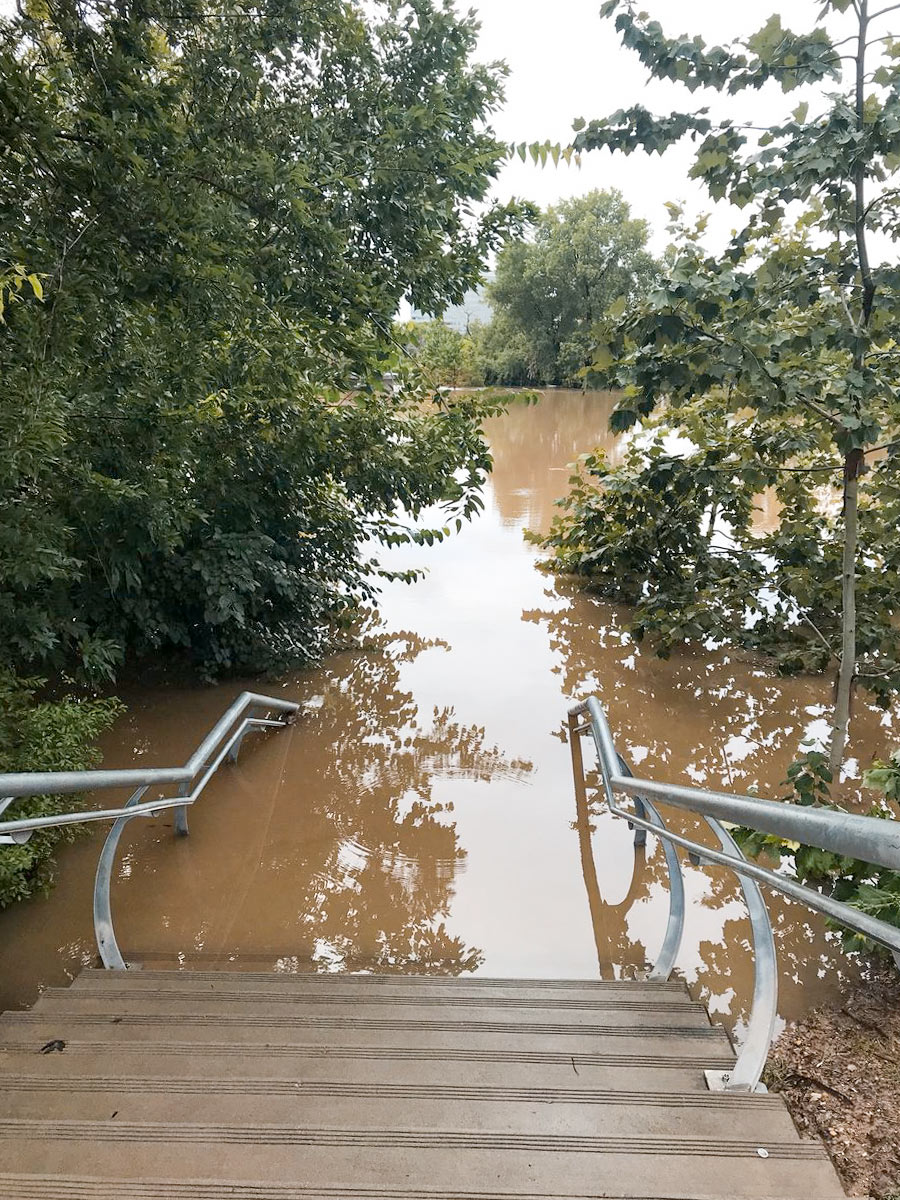
On-the-ground footage from KHOU reporter David Gonzalez shows just how much water the Johnny Steele Dog Park — redone and reopened 3 weeks ago following its last flood — took on yesterday. By the end of the downpour, floodwaters had risen up a few steps from where the park begins at the foot of the staircase leading to Allen Pkwy., as shown in the photo above.
That left these 2 out of luck:
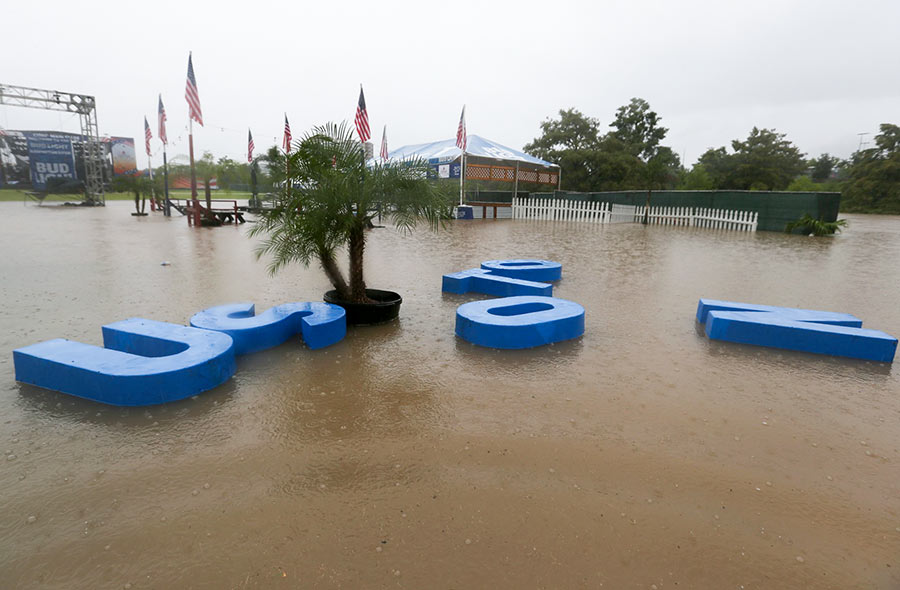
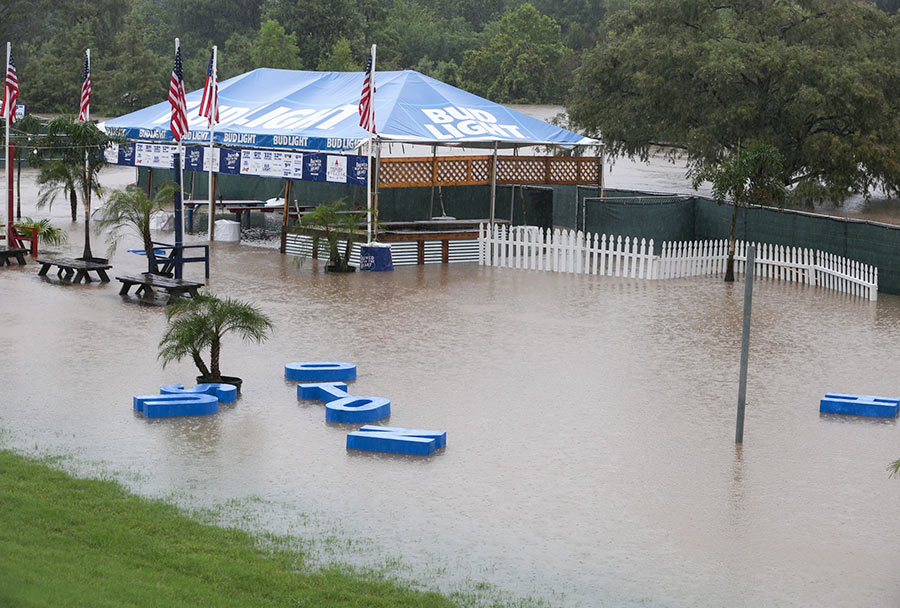
Mayor Turner had already cancelled all Freedom Over Texas events yesterday — save for the fireworks — by the time the HOUSTON sign planted in Eleanor Tinsley Park got caught up in the flow of things and began drifting downstream, away from the Bud Light Beer Garden that it originally fronted. Despite the disorder, the letters managed to stay afloat during their time on the water, captured by Chronicle photographer Yi-Chin Lee.
They ended up making landfall in the middle of the lawn:
COMMENT OF THE DAY: THE SLEEPY STREETS HARRIS COUNTY FLOOD BUYOUTS LEFT BEHIND 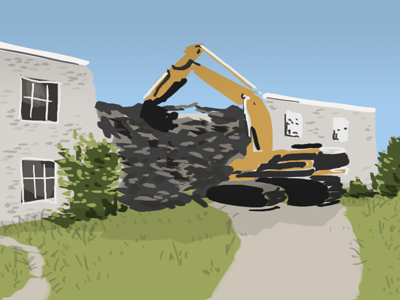 There is a community close to 290 and Windfern, on Cole Creek Dr. and another near Fairbanks and Hollister on Woodland West. Deep in the flood neighborhoods that were bought back by Harris County Flood [Control District] a while ago. All of the roads, utilities and everything are there. Just no homes or homeowners. Made a great place to take a post-lunch car nap when I worked close by. [bocepus, commenting on The Latest Wave of Harris County Home Buyouts, Mapped] Illustration: Lulu
There is a community close to 290 and Windfern, on Cole Creek Dr. and another near Fairbanks and Hollister on Woodland West. Deep in the flood neighborhoods that were bought back by Harris County Flood [Control District] a while ago. All of the roads, utilities and everything are there. Just no homes or homeowners. Made a great place to take a post-lunch car nap when I worked close by. [bocepus, commenting on The Latest Wave of Harris County Home Buyouts, Mapped] Illustration: Lulu
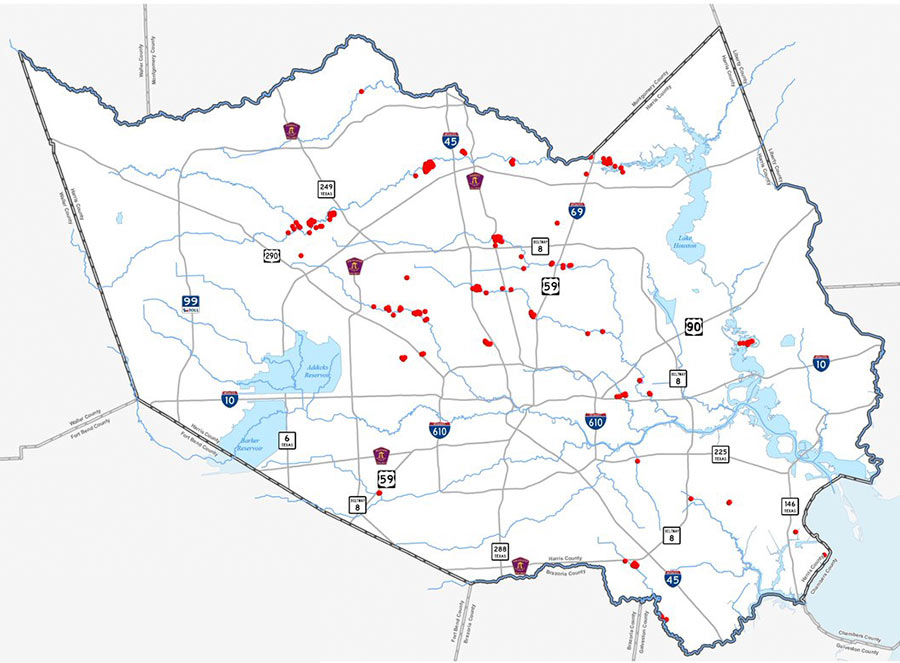
Now that a second, $51 million round of FEMA funding for home buyouts has come through, here’s the map of where the latest government snatch-ups are planned, 294 total. As indicated by the red dots above, they’re all outside the Loop — with a good portion grouped in 3 distinct clusters along Cypress Creek (which drowned out previous flooding records along nearly its entire length during Harvey). Other hotspots include several along White Oak Bayou, as well as a Greens-Bayou-adjacent bunch off Beltway 8 just north of Aldine and a San Jacinto River-side group south of Hwy. 90, near Highlands.
The money Harris County Flood Control District expects to receive for these purchases supplements an earlier $25.6 million FEMA committed to it on June 4. That previous check (along with an $8.6 million match the Harris County Commissioners okayed in order to get it) will be spent on about 169 buyouts, mapped out below:
THE ONGOING TRAVELS OF CITY HALL’S FLOODED-OUT BASEMENT EMPLOYEES  Shell has been allowing the city’s procurement staff to stay for free in 74,000 sq. ft. at One Shell Plaza, across Smith St. from the City Hall basement they were forced out of by Harvey’s floodwaters. (They’re joined in the office tower by IT employees from the city’s 611 Walker facility, which suffered its own water damage when its sprinkler system malfunctioned in December). But the free ride is coming to an end this month, reports the Chronicle’s Mike Morris: Shell is charging $70,074 for June rent. Now, the city plans to move its refugee employees again — this time to Enterprise Plaza (pictured above) at 1100 Louisiana where they’ll stay from July 1 to the end of next year at a rate of $93,380 per month for 69,000 sq. ft. (about $1.7 million total). After that, they’ll head back to 611 Walker, which the city plans to have ready for permanent residents by then. As for the damaged City Hall basement and the tunnel connecting it to the adjacent annex across Bagby St., their interiors “remain stripped, the walls peeling or patched with plywood, the wood veneers in one stairwell warped to mark the water line just below the annex’s first floor.” [Houston Chronicle] Photo of 1100 Louisiana St.: Hines
Shell has been allowing the city’s procurement staff to stay for free in 74,000 sq. ft. at One Shell Plaza, across Smith St. from the City Hall basement they were forced out of by Harvey’s floodwaters. (They’re joined in the office tower by IT employees from the city’s 611 Walker facility, which suffered its own water damage when its sprinkler system malfunctioned in December). But the free ride is coming to an end this month, reports the Chronicle’s Mike Morris: Shell is charging $70,074 for June rent. Now, the city plans to move its refugee employees again — this time to Enterprise Plaza (pictured above) at 1100 Louisiana where they’ll stay from July 1 to the end of next year at a rate of $93,380 per month for 69,000 sq. ft. (about $1.7 million total). After that, they’ll head back to 611 Walker, which the city plans to have ready for permanent residents by then. As for the damaged City Hall basement and the tunnel connecting it to the adjacent annex across Bagby St., their interiors “remain stripped, the walls peeling or patched with plywood, the wood veneers in one stairwell warped to mark the water line just below the annex’s first floor.” [Houston Chronicle] Photo of 1100 Louisiana St.: Hines
HOW TO PICK OUT THE RIGHT BOAT AND ONBOARD GEAR FOR HOUSTON’S NEXT FLOOD  “A good, 16-to-22 foot aluminum boat, it can take a lot of abuse if you were to hit a mailbox or something like that without doing damage,” says the Premiere Boating Center’s Mark Kuchera, speaking to Houston Public Media’s Gail Delaughter. He’s one of many exhibitors at the 4-day Houston Summer Boat Show where in addition to normal window shopping, many folks are either looking to replace boats lost or damaged in Harvey — or hunting for something that’ll do well in the next storm. Fishing boats are a good bet for floods, too, says David Christian of the LMC Marine Center (next door to Kuchera’s shop on I-45 near E. Airtex Dr.). Because your typical model is designed for shallow water, it “also happens to be what you need to float down a street.” Then there’s the equipment you’ll want to have aboard: “a spotlight and GPS are helpful for night rescues,” says Christian, and “A hydraulic jack plate can protect your outboard motor in shallow water.” Lower-tech devices aren’t bad either: “a long rod or stick can help you determine the depth of the water in unfamiliar places.” [Houston Public Media] Photo of Houston Summer Boat Show 2018: Houston Summer Boat Show
“A good, 16-to-22 foot aluminum boat, it can take a lot of abuse if you were to hit a mailbox or something like that without doing damage,” says the Premiere Boating Center’s Mark Kuchera, speaking to Houston Public Media’s Gail Delaughter. He’s one of many exhibitors at the 4-day Houston Summer Boat Show where in addition to normal window shopping, many folks are either looking to replace boats lost or damaged in Harvey — or hunting for something that’ll do well in the next storm. Fishing boats are a good bet for floods, too, says David Christian of the LMC Marine Center (next door to Kuchera’s shop on I-45 near E. Airtex Dr.). Because your typical model is designed for shallow water, it “also happens to be what you need to float down a street.” Then there’s the equipment you’ll want to have aboard: “a spotlight and GPS are helpful for night rescues,” says Christian, and “A hydraulic jack plate can protect your outboard motor in shallow water.” Lower-tech devices aren’t bad either: “a long rod or stick can help you determine the depth of the water in unfamiliar places.” [Houston Public Media] Photo of Houston Summer Boat Show 2018: Houston Summer Boat Show

